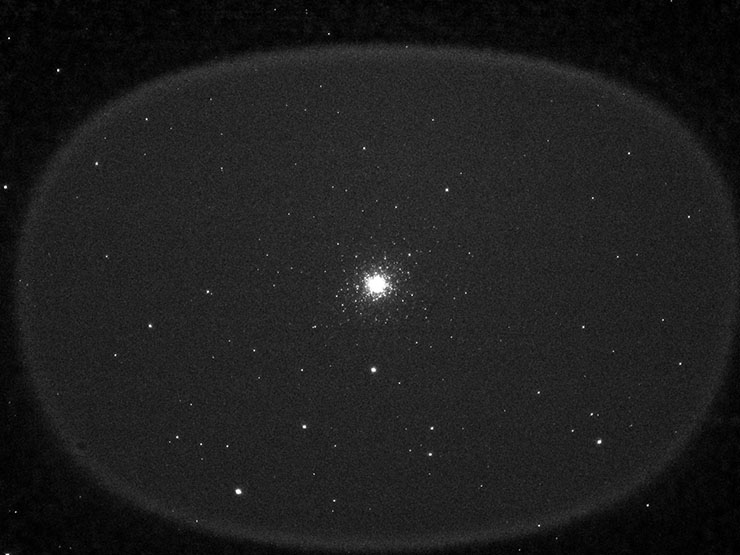|
9/22/2010: Maintenance and mods.

I guess it's a moisture thing. Anyway, this odd vignetting
is why M13 on the previous page was cropped more tightly than I wanted.
This is the 20th subframe from the blue channel, stretched so far as
to be ugly in order to see the fault, but they're all similar.
Here's what I did: Remove desiccant plug from ST2000XM;
cover opening. Remove o-ring from plug and stash in a prominent, safe
spot. Bake plug at 375°F for three or four hours. Keep plug in
a sealed container while cooling. When plug cools, return the o-ring
to the plug. Replace desiccant plug in ST2000XM. We'll see what happens
next time. Later that same week, I ordered the desiccant module from
Particle Wave Technologies, because clear nights when I put the CCD
to work are rare enough that I don't want to lose many while waiting
to perform this bit of kitchenery.
9/23/2010: I got my mind right, made
a jig, measured twelve times, removed the lens, focuser, and focuser
adapter ring from the A-P refractor. I stuffed much of the tube with
rags. And then I used the miter saw and a nonferrous metal blade to
lop an inch and an eighth off the tube. Everything that would focus
before should still focus; nothing that required an extension will
need more of an extension, and nothing that didn't require an extension
should need one now. In addition, the focal reducer should again be
useful for both the SBIG and Canon cameras. And if the FeatherTouch
fine-focus adapter can be used in more configurations, better. The
whole kit should be more airline friendly too, especially since the
focuser threads on and off easily (if I ever intended to fly with it
again, which I don't, but who really knows?).
The mail lady just handed me a TeleGizmos telescope
cover from HighPoint Scientific. I bought the model made for 6-inch
refractors on large equatorial mounts. I thought it might cover virtually
all of the 5-inch on the Mach1. Does, too.
Sky trials: total success! The ST2000XM
now comes to focus behind the telecompressor and the same custom
made spacer I turned to use with the A-P's original focuser. The new-to-me
A-P focuser is racked out hardly at all (the telecompressor and 2-inch
clamp ring are just barely clear of the focuser body). No diagonal.
This imaging train produces an EFL of 546.9mm = F4.3 = 2.79" per
pixel. So the nominally 0.75x telecompressor is working at 0.717x.
All these measurements are via Pinpoint Astrometry in Maxim DL5, based
on the full frames of photos of M57 and environs. Here's a first look
at the aligned, stacked, combined and cropped data:

It's worth clicking the image to see Messier 57
in context
600s total exposure with a full Moon rising
behind me. That's a very tightly cropped image (cropped so that you
can see some detail in the reduced, websized graphic). 10x20s in
each of R, G and B with the chip cooled to -15°C. I controlled
the camera in Nebulosity 2, processed data in Maxim DL5 and finished
the image in Photoshop CS4. I focused in the L channel, then shot B
and G. I finished wtih R after refocusing slightly. (Note that Ha focuses "out" with
respect to the other filters.) Ha and luminance data
are not used in this image. No guiding. I applied a single 20s dark
to each subframe. Look at that delicate central
star. This RGB stuff could get to be a habit.
The bizarre vignetting I saw last
night is gone.
I packed up the ST2000XM and the computer, threw the
TeleGizmos cover over the telescope and mount, and I was inside in
five minutes or less. Good deal. And good night! |